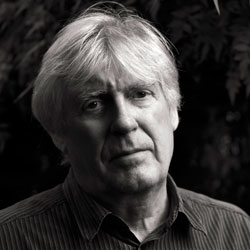Not everything dead is buried in that place
of rapid shadows. They’re all in place, some head-
to-tail or arse-up, some cheek-by-jowl or face
to face (whether or not they were married), some in place
of others who say there’s nothing to be said
and turn the earth at night and know their place.
The markers are blank, since everything’s taken as read
in a place like that. Not everything buried is dead.
Notes on the Poem
We don't mean to be morbid, but we seem to have returned to the subject of final resting places, which we considered recently in Rodney Jones' poem "I Find Joy In the Cemetery Trees". How does Jones' approach contrast with that of David Harsent's in "Arena"? In the Jones poem, the setting is earthy but the overall effect is one of peacefulness. As Harsent establishes his setting with: "Not everything dead is buried in that place of rapid shadows." there is already an undercurrent of anything but peace, even of menace. Reverence for the trees shading the cemetery and, by extension, reverence for those being shaded, comes through convincingly and poignantly in the Jones poem. The dead in Harsent's poem are in a setting not nearly so pastoral and respectful, evident from the title of the poem. The dead were clearly treated cruelly before death, and the state and placement of the bodies is disrespectful and degrading. It seems pointless to have markers at all since they are blank, but adding to the sense of menace is the observation: "since everything's taken as read in a place like that." Harsent's poem is framed ominously with ... "Not everything dead is buried" and "Not everything buried is dead." ... leaving the reader feeling nervous, apprehensive and haunted, in stark contrast to the just and settled sense of peace and solace of Rodney Jones' poem.
